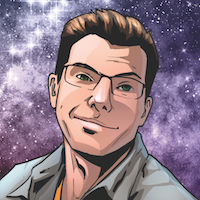Creature Features: Faces
Early on, when we were still planning out the core elements of StarPower, Michael told me that he wanted life to be as common as dirt. He may not have used those exact words, but sci-fi tends to fall into one of three categories where aliens are concerned: They Don’t Exist, There’s A Handful of Sentient Races, and It’s Freaking Star Trek Up In Here and he had strong feelings about which category StarPower should fall into. The end result is we wanted the galaxy to be awash with different species and I knew this would make things…interesting for me.
Thus far, I’ve gotten quite a few comments from people saying they like all the various aliens we’ve seen in the comic. There’s the occasional criticism, but over all people seem to find the alien life in StarPower to be well thought out and interesting. So I thought I’d take some time to talk about things I consider when I’m designing lifeforms.
Faces
I try to make sure my aliens have a discernible face. This is mostly for the reader’s benefit, as 1. it gives us somewhere clear to look at our alien (especially since humans spend a shocking amount of time looking at each other’s faces), and more importantly 2. it allows for emotional expression. Yes, you absolutely CAN convey emotion through just body language (though why aliens would have the same mannerisms as humans is anybody’s best guess), but a face easily lets things be expressed that would not otherwise come through in just text. I would be less concerned about having facial expression if we could hear the alien’s, but we can’t in this medium, so there. A face also acts as a point of commonality, and helps us relate to the being as another person with feelings and hopes and dreams (no matter how odd seeming) and not just a creature. One of the reasons the Prawns were so excellent in District 9 was because despite their downright off-putting alien nature they had those all-too human eyes that stared mournfully back at us.
One thing I DON’T like about a lot of Star Trek style aliens is that they often end up as “humans with funny skin color” or “oddly shaped ears” but are otherwise nearly identical to human beings. I try hard to make sure my aliens are CLEARLY ALIEN, and this often happens most frequently by keeping human faces off of alien bodies. I’ll change shape of the skull, alter eye shape, number of eyes, shape of mouths, but most notably I don’t put human noses on aliens. Or at least, I’ve yet to do so. I think I do the same thing with ears. There’s something distinctly human about noses and ears for me. Not sure why, but they all too often feel like dead giveaways that “this is an actor in makeup.” So I try to avoid it. Which is shockingly easy. Even if you’re using the same parts, eyes, nose, ears, mouth, and they all work is more-or-less the same fashion, the possible alterations to those parts you can make to make them eerily inhuman but still capable of forming decipherable expressions is nearly infinite. You can do a lot with a face.
Thursday, I’ll talk about another aspect of alien design: humanoid bodies (or lack there of).
